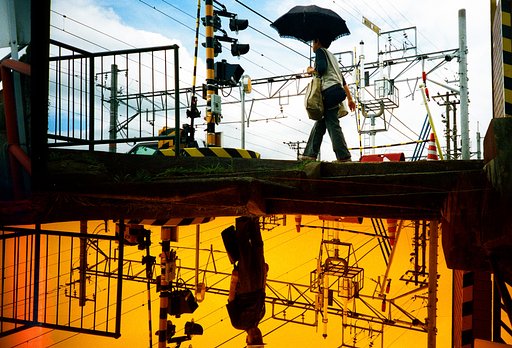What are the best Lomography cameras for beginners?
Lomography has many cameras made for different occasions. For taking your first journey into film, wanting to learn the more technical side of photography, or even just letting loose and experimenting, there is a Lomography camera for you. This list highlights five cameras: the Simple Use Camera, Fisheye No. 2 35 mm Camera, La Sardina, the Lomo LC-A+, and the LomoApparat which are all great starting points to your analogue journey.
Simple Use Camera
The Simple Use Camera is a great way to start your analogue journey with a straightforward point-and-shoot camera pre-loaded with film and can be reused time and time again. Coming preloaded with either the CN400, LomoChrome Purple, LomoChrome Metropolis, or LadyGrey films, the Simple Use Camera is also a great way to try out the Lomo series of films, as well as one of the Lomo techniques known as coloursplashing.




Fisheye No. 2 35 mm Camera
The Fisheye No.2 is a great point-and-shoot camera that lets you start experimenting with composition. Its 170 degree view allows you to get the classic fisheye look but features such as the bulb mode give users the opportunity to be creative with low light photography and long exposures.
Another great feature of this camera is the multiple exposure switch. This allows users to stack photos on top of each other and gives them the power to create new images in an instant. Portable, lightweight, and even coming with a powerful flash, this is a camera that is ready to capture anything at any time.




La Sardina
This uniquely designed camera, inspired by a sardine can, has a 22 mm wide-angle lens and is perfect for beginners due to its ease of use combined with its many features which give it serious potential for experimentation.
The La Sardina’s zone focusing system makes everything simple. Just select between “0.6 m~1 m” or “1 m~infinity.” Taking multiple exposures is also a walk in the park with the it’s MX button and simple rewind knob. The possibilities are endless and the effects are always unexpected. There’s also a bulb setting for long exposure experimentation in low light.
You can even dress it up with a range of dapper covers or customize your own with the La Sardina DIY.




Lomo LC-A+
The Lomo LC-A is the camera that started the whole Lomography movement. With its famous Minitar 32/2.8 lens, it gives the sought-after contrasts and vignettes that Lomography is famous for. The Lomo LC-A+ expands on the camera and adds newer features from the original such as a multiple exposure button and an expanded ISO range up to 1600. The camera also is great for learning how to take long exposures as the shutter speed goes from 1/500 to unlimited.
Beyond the technical side, the Lomo LC-A+ is a great introduction to taking control of your photography by learning how aperture, different ISO, and shutter speed can affect your photos and create unique effects




LomoApparat
The LomoApparat 21 mm Wide-angle Camera is a versatile camera that is perfect for both beginners and seasoned Lomographers. It is incredibly lightweight and is designed to be intuitive and simple to use, which makes it ideal for capturing candid moments without stopping to adjust the camera’s settings.
Like other cameras on this list it includes an easy-to-use multiple exposure function and many additional features that make it a great all around camera for everyday use.
The LomoApparat’s accessories, such as the splitzer and flash with interchangeable colour gel filters, open up a whole world of creativity for those who want to experiment. Also included with the LomoApparat are two additional lenses, a close-up lens, as well as a super fun kaleidoscope Lens. With these the LomoApparat becomes much more than a basic point-and-shoot.




Anything missing?
Can’t find an answer to your question? Or do you have some useful advice to add to one of our courses? We want to build the world’s largest analogue learning space, so please send any further requests or information to school@lomography.com and we’ll take a look!
More Courses
-
What is a Lomographic picture?
A Lomographic picture usually mixes the golden rules of Lomography and a few of the defining characteristic styles. However, nowadays a Lomographic picture is entirely up to your own creativity.
-
What is a LomoWall?
A LomoWall is a vibrant and colorful artwork that utilizes analogue photography to celebrate the talent and diversity of countries, cultures and people. This record-breaking and collaborative practice has always been an important part of our story.
-
What is the LomoLab?
The LomoLab is our film developing and scanning arm of Lomography. Found in Vienna and only available for mainland Europe, you can send in your rolls directly to us at Lomography – LomoLab, Kaiserstraße 34/12, 1070 Vienna, Austria.
-
What is a LomoAmigo?
A LomoAmigo is an artist we collaborate with. They bring their own unique styles to our products and we publish articles in the Lomography Magazine highlighting their work.
-
What makes Lomography cameras different from other film cameras?
Lomography cameras are different from other film cameras because they’re designed to be easy to use with film experimentation in mind.
-
What is a LomoHome?
Your LomoHome is your gateway to sharing your photos and yourself on Lomography.com. It’s where you can upload your photos, create albums, and keep up with your friends’ latest activities.
-
What is Colorsplashing?
Colorsplashing is a technique where colored filters are attached to the flash to change the original white color. Colorsplashing will give you the opportunity to bring any mood to photos with the full range of the color wheel at your disposal.
-
What is cross processing?
Cross processing (or “X-pro”) is the procedure of deliberately processing film in a chemical solution intended for a different type of film. As each chemical mixture is optimized for a specific kind of film, you will get unpredictable results when combining them differently.




